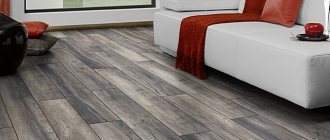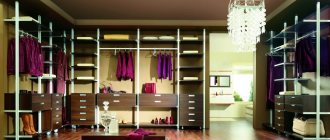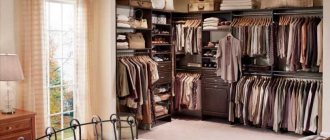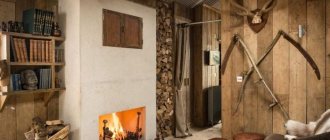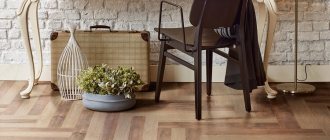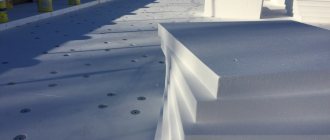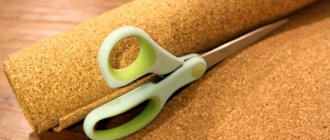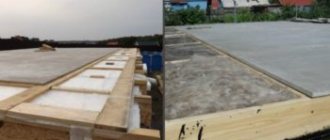Coniferous substrate came to Russia from Europe (its homeland is Finland). There it is laid under laminate and parquet, but only if the base is a wooden subfloor. The Russians adapted it to local realities and began to lay it on concrete (cement screed). Therefore, many questions arise from customers to specialists, and from those to manufacturers - most of their recommendations are impossible to implement in principle. There are also contradictions: laminate manufacturers remove warranties if there is no waterproofing, and underlay manufacturers do not recommend laying it on film.
general description
Coniferous backing is made from needles and wood from spruce and, to a lesser extent, pine. The wood is crushed, evaporated, and then pressed together with the needles. The binder is the resin of these same trees.
Characteristics
The use of wood and pine needles for the production of linings for laminate floors made it possible to obtain a material with good quality characteristics:
- Excellent damping properties, allowing you to effectively dampen floor vibrations;
- The ability to well level out foundation errors;
- High elasticity, which protects the lamella locks from destruction for a long time;
- Durability. In terms of service life, according to manufacturers, the substrate is 1.5-2 times longer than laminate;
- Low thermal conductivity, which allows you to get a good result in maintaining heat in the room without additional measures for floor insulation;
- Sufficient level of noise protection.
Main dimensions (thickness)
Wood underlay for laminate is produced mainly in the form of sheets measuring 590x790 mm with a thickness of 3 mm to 7 mm. The Polish one has the largest range of products in terms of thickness: 3 mm, 3.6 mm, 4 mm, 5 mm, 5.5 mm and 7 mm. Isoplaat (Estonia) also produces sheet substrates with dimensions of 590x790 mm, but thicknesses of 4 mm, 5 mm, 6 mm and 7 mm. You can also find rolled coniferous backing on sale.
The variety of underlays for laminate flooring in terms of thickness allowed Steiko to surpass all competitors on the Russian market. After all, it is the 3 mm underlay that is considered the most optimal in size for the final floor covering. Thicker substrates are used when there are significant defects in the poured screed. For example, a thickness of 4 mm well levels out height errors of 1-2 mm, and a thickness of 5 mm – 2-3 mm.
Thicker substrates are used either under a luxury class laminate, or under an ugly floor screed, where height differences reach 5 mm. But even a coniferous backing will not help if the screed has height errors of more than 5 mm. The correct solution to the problem here is to use self-leveling mixtures.
Popular manufacturers
In Russia, Polish is the most popular. Its products can be found in various parts of not only Russia, but also the CIS countries. High quality and reasonable prices (compared to other manufacturers of similar products) made it a sales leader.
STEICO Underfloor
Another well-known brand, Isoplaat (Estonia), is rapidly losing its position in the country. The reason is not the quality of the substrates, which is always the highest, but the high price. The quality level of competitors with a lower price is quite enough for the entire life of the floor covering: parquet, laminate, linoleum. Estonian underlayment is mainly used for expensive parquet flooring. Here it is out of competition with other types of substrates, including those made from balsa wood.
Sellers of building materials are increasingly recommending the purchase of Leroy Merlin (Russia and Poland), LATTIALEIJONA (Finland) and Cezar (Poland) substrates.
Average market price
Until recently, prices in the Russian construction market were dictated by the main players in this building materials sector: Steico (Poland) and Isoplaat (Estonia).
At Steico, prices started at 98 rubles/m2 for a 3 mm substrate and grew as the material thickened:
- 4 mm - from 119 rub./m2;
- 5.5 mm - from 145 rub./m2;
- 7 mm - from 175 rub./m2.
Please note that the prices listed are for the lowest density substrates. As this indicator increases, prices also rise accordingly.
They have a slightly different approach to pricing - they have left the lower price sector and produce material that is denser than . Therefore, the cost of their products starts:
- 4 mm - from 160 rub./m2;
- 5 mm - from 170 rub./m2;
- 6 mm - from 190 rub./m2;
- 7 mm - from 214 rub./m2.
The emergence of new players on the market has significantly shaken the positions of these firms, especially Estonians. Imports of Isoplaat substrates to Russia have decreased significantly. They were replaced by:
- Leroy Merlin (Russia and Poland);
- “LATTIALEIJONA” (“Lattilona” Finland);
- "Cezar" (Poland).
The most active is the Polish company Caesar, whose 4 mm thick substrates are cheaper than 3 mm Steico substrates (from 96 rubles/m2).
TOP 3 manufacturers of substrates based on pine needles and wood
| Photo | Name | Rating | Price | |
| #1 | Steico underfloor | ⭐ 98 / 100 | More details | |
| #2 | Leroy Merlin | ⭐ 97 / 100 | More details | |
| #3 | Isoplaat | ⭐ 96 / 100 | More details |
Steico underfloor
This spruce underlay is good where soundproofing of floors is important. Supplied in slab form. Ideal for laying under laminate on wooden floors. Often used in private homes. Steico is a leader in the production and sale of this type of substrate.
Steico underfloor (Poland)
pros
- perfectly dampens the sound of steps when moving along the base;
- has excellent thermal insulation properties;
- able to resist moisture well;
Minuses
- afraid of mold.
coniferous underlay Steico underfloor
Leroy Merlin
It acts as a capacitor for the lamellas due to the fact that it is subjected to special processing during manufacturing. This substrate is cheaper than the previous option, but its performance characteristics are quite good.
Coniferous backing from Leroy Merlin
pros
- ideal ratio of cost and quality;
- good soundproofing qualities;
Minuses
- not detected
coniferous backing Leroy Merlin
Isoplaat
The material is able to retain its shape for as long as possible. Suitable for repairing old floors.
Isoplaat (Estonia)
pros
- does not deform;
- absorbs noise well;
- can act as an insulating material;
- does not allow the laminate to cool quickly.
Minuses
- the cost is above average.
coniferous underlayment Isoplaat
Advantages and disadvantages
The short service life of a coniferous substrate on a concrete screed base leads to advantages and disadvantages that are not entirely correctly formulated. Sometimes they come into conflict with the practice or opinion of professional finishers.
For example, theorists indicate that the installation process is not difficult and can be done with your own hands. This does not require any devices or tools - glue, tape, film, etc. Craftsmen who work with these materials, on the contrary, consider the technology of laying the substrate complex and unpleasant.
It cuts poorly, the joints must have a gap of at least 1 mm, which is very difficult to do due to uneven edges, it is laid diagonally to the laminate (this is an additional difficulty in cutting it), it cuts into arms and legs (like fiberglass), etc.
The materials available on the Internet are either written for advertising purposes, or borrowed by the authors from one source for various specialized sites. The backing is very expensive, so consumers should know the real advantages and disadvantages of this material.
So, coniferous underlay for laminate flooring, what are its pros and cons. The advantages include:
- Long service life - does not sag or lose elasticity for 15-20 years. It is too early to talk about a longer period of preservation of quality characteristics - there is no statistical data;
- Low thermal conductivity. The porous structure of the substrate and the material from which it is made make it an excellent insulation material that retains heat well in an apartment even in the northern regions of the country;
- High density , allowing you to completely hide the sharp protrusions (various pebbles) of the subfloor. At the same time, due to its strong density, the substrate cannot level out rises in the floor of a slightly larger size (4 cm or more in diameter) - it does not dent, but bends, which is transferred to the laminate. And this is a serious minus;
- The ability to walk on the backing sheets during installation , which is prohibited with other types of lining;
- The ability to level out errors in the base of the floor with a height difference of 1-3 mm. Almost the only type of lining (other than cork) that can cope with such defects. But here it is necessary to use a thickness of 5-7 mm;
- Elasticity , which allows the material to withstand higher static and dynamic loads compared to other types of substrates (it holds 15-20 tons per 1 m2 perfectly on a laminate);
- Good noise protection. The situation here is ambiguous. According to manufacturers, the sound insulation of the material is average - the sound absorption coefficient is only 19-22 dB and only structural noise is damped. However, numerous user reviews on various forums indicate the opposite - all types of sound are absorbed and very effectively. The room acquires a comfortable acoustic atmosphere;
- Fire resistance. Surprisingly, neither in the materials about this type of substrate, nor in the comments of professionals, this advantage is indicated. For some reason, the results of fire resistance studies posted in the public domain went unnoticed. And they claim that under the influence of open fire, the coniferous lining material does not support the combustion process - it only becomes charred. Without a doubt, such a result is possible only after impregnation of the substrate with fire-resistant mixtures;
- Environmental Safety. Both manufacturers and finishing specialists talk about this aspect of building materials. On the one hand, they are right. Indeed, in the production of the substrate, only natural materials are used, without foreign synthetic additives. Even the adhesive is tree resin. But on the other hand, no one mentions fireproof impregnation, which significantly devalues this quality of the coniferous substrate.
There are also significant disadvantages:
- High price;
- Cannot be used in the kitchen, bathroom or toilet - it absorbs moisture and does not dry well. Under the influence of a large amount of water it simply collapses;
- Contrary to the assurances of manufacturers that the porous structure of the substrate cannot accumulate water and, therefore, does not serve as a breeding ground for fungus and mold, wet pine needles turned out to be a favorable basis for the proliferation of various fungi and molds. This is evidenced by numerous consumer reviews;
- It cuts poorly with both a knife and scissors. Experts ask theorists who claim the opposite to experiment and cut a bunch of spruce needles. During cutting, the material crumbles rather than cuts;
- Unpleasant odor in the first few weeks after installation;
- It collapses under the weight of an adult at the connecting seams immediately after installing the laminate, which has a sharply negative effect on the interlocking connections of the lamellas. The trouble is due to the different density of the middle (it is higher) and the edges (lower). Over time, the edges become compacted due to the redistribution of the substrate mass and this effect disappears. Customers who are not aware of this feature of the pine needle lining always blame the finishers.
Main characteristics
The use of needles and coniferous wood in the production of the substrate gives the material many positive properties:
- high damping characteristics that allow you to dampen any floor vibrations;
- leveling differences in base height without any extra time;
- high degree of elasticity, which allows you to protect the locking connections of the lamellas from destruction for many years;
- the operational service life of the substrate, as the manufacturer assures, is not just equal to that of laminate or parquet, but exceeds it by 1.5 and even 2 times;
- low level of thermal conductivity, which allows you to retain heat in rooms without any additional insulation measures;
- good noise and sound insulation.
These positive characteristics have made coniferous underlayment popular when installing laminate or parquet floors.
Features of laying the substrate
The small size of the backing sheets leads to frequent coincidence of the connecting seams of the laminate with the joints of the backing sheets, which inevitably leads to the destruction of the lamella locks. How to lay coniferous underlayment under laminate in this case? Manufacturers recommend laying the underlay diagonally relative to the direction of laying the laminate.
The instructions are quite simple:
- Bring the substrate into the room, unpack it and leave it for 2-3 days so that it takes on geometric dimensions in accordance with the temperature and humidity that exist there;
- Waterproof the screed with plastic film, despite the manufacturer's recommendation to lay the underlay directly on the base of the floor. This prevents condensation moisture from entering the needles, which causes mold development and fungal growth;
- For sheets laid to the wall at an angle of 45 degrees, a triangle is cut with a construction knife or scissors. It is not thrown away - it will be stored somewhere else. When cutting with a knife, you need to attach a metal ruler or lamella to the cut line - this makes cutting more convenient;
- The sheets are laid at an angle of 45 degrees relative to the wall. A technological gap of 5 mm is left between the wall and the substrate, and 1-2 mm between the sheets of the substrate. Gaps are needed to compensate for the expansion of the lining under the influence of sudden changes in temperature and humidity;
- The joints must be sealed with metallized adhesive tape - construction tape simply does not stick to such a surface.
and Isoplaat recommend taping each sheet to the base of the floor. But we must not forget that initially coniferous underlayment was intended for wooden subfloors, which do not require waterproofing. Here such an operation makes sense, since it firmly fixes the substrate in a certain place. It is useless to attach the backing to the film - it will move along with the waterproofing.
Extruded polystyrene sheet backing – wide choice of thicknesses
When people ask me what kind of backing to buy, I don’t recommend sheet backing. However, I often put it down. From which we can conclude that sellers are actively working with it, selling it together with laminate.
Sales people explain the advantage of this insulation, compared to foam, in its higher density and service life. Theoretically this is true, but in practice it is unknown. The fact is that extruded polystyrene foam is also a gas-filled material, a little more dense, but brittle and brittle. It keeps its shape better, but by how much is unknown. I met pressed polystyrene foam and foam bedding.
During assembly, lightweight slabs fly apart under air currents, so they need to be secured with tape. Available in different packaging sizes. I recently laid sheet Arbiton; the sheets from one pack were of different lengths. There was no need to talk about the accuracy of the joints.
Expanded polystyrene in Maxidom in the form of an accordion
The speed of laying sheet material is significantly lower. Once, while ordering, he suggested that the girl, to save money, lay out the sheets herself and fasten them with tape, showing how it was done.
The speed of laying laminate flooring was not inferior to her. She said several times: “Alexander, you are breathing down my back.” I imagined myself as a skier on the piste.
Plus sheet polystyrene insulation in a large selection of thicknesses - 2,3,5,7 mm. The foam analogue also has linings of different thicknesses, but due to the soft structure, I would not recommend using more than 3 mm. But polystyrene with a thickness of 5 mm and higher is also dented, although more slowly.
The average density of extruded polystyrene foam is about 35 kg/m3. The price of the substrate is about 50 rubles/m2.
I could lay it myself to level the floor with tiles, taking a thickness of 5-7 mm. Or if it is impossible to knock down cement deposits on the base, using 5 or 7 mm slabs. I would not use 3 mm polystyrene. It’s better to take Tuplex or Profitex then.
Which substrate is better, coniferous or cork?
In terms of quality characteristics, cork substrates are superior to coniferous ones. But there are points that need to be taken into account:
- The difference in price for these types of substrate does not correspond to the difference in quality between them - cork is much more expensive than pine needles, having only a slight advantage in terms of quality characteristics;
- Both materials have excess quality indicators for laminate flooring;
- The only point where you can doubt when buying a coniferous substrate is that fungi do not grow on the cork and mold does not multiply. However, with properly installed waterproofing, such a problem should not exist in principle even on pine needles.
Which one is better to put?
The choice of substrate depends on several main factors that are important to pay attention to:
- Floor quality. If the surface is not very well leveled, then you will have to use polystyrene foam or cork of considerable thickness. In another case, you can get by with a thin layer of foamed polyethylene.
- Microclimate. If moisture forms on the floor surface, then it is important to take care of its insulation. To do this, polyethylene films are combined with other types of substrates. An alternative is polystyrene foam, which does not allow moisture to pass through.
- Technical specifications. When choosing, it is important to consider whether the substrate can not only level the surface, but also provide the required level of sound or heat insulation. This factor is important if the floor installation is carried out on the first floor of a private house or apartment in a multi-storey building.
Characteristics
The coniferous substrate has the following quality characteristics:
- effectively dampens floor vibrations;
- eliminates base errors;
- protects locks from destruction for a long time;
- helps retain heat in the room;
- has an excellent level of noise protection.
Based on numerous reviews, the coniferous backing under the laminate can be cut well with a knife and, due to its different thickness, makes it possible to raise the laminate to a height comparable to tiles. The material also perfectly absorbs moisture and protects the floor covering from it. But it is worth noting that the material has different thicknesses. The scope of its application will depend on this. You cannot use an excessively thin or, conversely, thick model.
The worst underlay for laminate is a roll of extruded polystyrene
Having written such a title, I feel awkward describing a low-quality substrate. After all, sellers do not have a bad product and you will have to dispute it with numerous commentators.
However, I encounter it quite regularly when laying and I would like to protect readers from such a purchase. Let me explain my position. Each insulation has advantages and disadvantages; this product has no advantages, except for its relatively low price.
Rolled sound insulation for the floor under a laminate made of extruded polystyrene foam is the most uncomfortable underlay I have come across in my work. The complexity of the flooring lies in the constant rolling of the roll and the fragility of the material.
When the canvas is rolled out, the cut end is bent. You have to press down with improvised objects. The curl is so high that it moves the hammer on the wooden handle. The fragility of polystyrene foam guarantees broken edges, which, however, can be glued with tape. But it will look like a collective farm.
The negative qualities of this chemical industry product include its thickness - it is only 2 mm. I've heard reviews that XPS insulation is better than foam insulation and maintains a stable thickness longer. I deeply doubt this. In my work, I have been involved in the dismantling of floor coverings with a laid polystyrene foam underlay. She became thin, like a sheet of paper. But I came across one in good condition. Apparently, the suitability of the old lining depends on the intensity of foot traffic, the amount of furniture in the room, and the evenness of the floor.
Once, while laying such insulation in a hairdressing salon, I asked: “Why did you buy an extruded polystyrene backing?” To which came the following response: “This lining has fire safety certificates.”
There is probably an incorrect interpretation of the facts here. Since any substrate has a certificate of fire compliance with standards. The conclusion is quite vague, would you agree!? The shock absorption of XPS in terms of flammability class - G4 and smoke generation - D3 is the same as polyethylene foam bedding.

